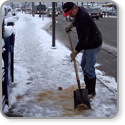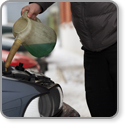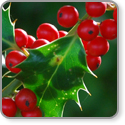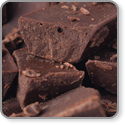Our second hazard is antifreeze, a popular engine coolant containing ethylene glycol that can be found anywhere vehicles drive or park – streets and roadways, parking lots, and even your own driveway. Antifreeze is not exclusive to Winter, as it is used to control the freezing and boiling point of liquids, making it prevalent in warmer months, as well. While pets may be drawn to this extremely toxic substance because it has a sweet taste, you can recognize antifreeze by its fluorescent green color. In the clip above, Dr. Mahaney tells us what to watch out for when it comes to pets and antifreeze this Winter.
Easy tips to protect your pets from antifreeze:
- Don't walk your pet in locations where cars park.
- Always take your car to a professional repair shop for the antifreeze to be changed. Don't change it yourself in your driveway.
- Keep your cat indoors so they will not be tempted to lick sweet antifreeze.
- Look for antifreezes that contain propylene glycol, which has a higher margin of safety in the event of ingestion than ethylene glycol.
If you suspect your pet has ingested antifreeze, please see your veterinarian immediately.













